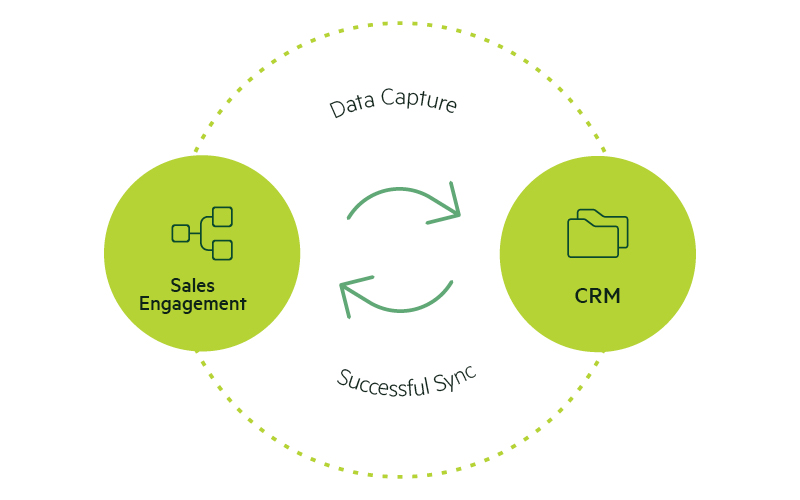What Is Inside Sales?
Inside sales refers to the practice of remote selling, wherein inside sales representatives solely use technology to conduct sales activities. The channels that inside sales reps use to acquire and connect with potential clients depend on your product, sales strategy, and clientele.
The rise of remote selling has blurred the line between inside sales and outside sales. In fact, even before the pandemic, Harvard Business Review reported field salespeople interact with customers remotely more than half of the time. This model is more cost-effective and scalable than outside sales.
What Is Outside Sales?
Outside sales (also known as field or face-to-face sales) refers to the practice of selling in person, wherein outside sales representatives fly out, meet, and conduct in-person meetings with potential customers. Outside reps also attend industry events to present live demonstrations and connect with potential prospects.
Outside sales activities are designed to be autonomous and flexible. Salespeople who specialize in outside sales deliver a personalized sales experience and foster strong customer relationships over weeks or months. For this reason, outside sales professionals report an average close rate of 40% with 65% of outside AEs attaining quota—10% higher than that of inside reps.
Whether you’re doing inside or outside sales, close more deals with Salesloft’s sales engagement platform.
Comparing Inside Sales Reps vs. Outside Sales Reps

Inside sales and outside sales reps share the same goal: to generate more revenue. That said, there are key differences that set inside and outside sales apart.
The Sales Cycle
The inside sales cycle is shorter and targets smaller deals. During short sales cycles, inside salespeople prioritize the volume of sales rather than singular, high-quality prospects.
Likewise, shorter sales cycles mean inside reps have less cycle complexity and fewer stakeholders to contend with—streamlining the sales process overall. They primarily focus on remote sales activities, like phone calls and sending emails.
Meanwhile, the outside sales cycle is longer and more complex because it targets high-quality, high-value accounts. The outside sales cycle is also more expensive than the inside sales cycle because it usually requires extensive deliberation.
Deals can take weeks, months, or possibly years to close, depending on the deal size. Additionally, outside salespeople often need to meet with decision-makers in person to deliberate (though the COVID-19 pandemic has shifted this aspect).
The trade-off is that outside sales bring in higher revenue-generating deals through highly personalized sales experiences.
Sales Tools
To put real-time insights into action, successful sales teams use a customer relationship management (CRM) system and sales engagement platform together.

Your CRM stores and organizes customer contact information and records interactions. A complete sales engagement platform, such as Salesloft, uses automation to create hyper-personalized buyer interactions at scale and manages pipeline, opportunities, forecasting, and coaching.
Within these sales tools there are capabilities that are critical for inside sales reps, such as multi-channel messaging and communication workflows. Other sales development tools that will come in handy include video, prospect research, and buyer intent software. Make sure you choose a sales engagement platform with these integrations!
While field reps spend more time in meetings, they still rely on email, calls, and LinkedIn to communicate with prospects. When all these activities automatically sync from the sales engagement platform to the CRM, reps on the road can be more efficient. With many meetings remaining remote, choosing a sales engagement platform with robust video conferencing integrations, including Zoom, will ensure field reps have the tools they need.
Differences in Skill Sets
Different facets of selling call for unique skill sets. Inside reps need to know how to capture and hold a prospect’s attention, develop repertoire, keep their pipeline full, and build an efficient workflow that can withstand volume—made easier with sales technology.
Inside reps often have templates and scripts to follow, but to foster a connection and close deals, they must also be adept at research, timely communication, and problem-solving.
The time management skills, situational awareness, and emotional intelligence required by inside reps are needed even more among outside reps.
Functioning with a high degree of autonomy, outside reps are expected to adapt to unpredictable schedules and client needs. In-person demos take away the luxury of time, so they need to be able to think quickly on their feet. They must know how to handle objections during face-to-face interactions while maintaining conversation flow.
Metrics They Track
Both inside and outside sales teams use technology to track metrics and measure their performance, but they focus on separate types of sales data.
B2B sales managers and reps in remote selling use platforms like Salelsoft to measure success around their opportunities—from those created to those closed. Tracking activities like calls logged, emails delivered, and overall touchpoints per sales cycle improves visibility and helps sales leaders gauge performance.
Meanwhile, outside sales reps are tracking metrics related to pipeline movement, touches within the account, and efficiency to closed-won revenue. They can also use technology to track and manage their schedule, consolidate data, and monitor progress against quota and sales goals.
Frequency of Travel
The frequency of travel isn’t a concern for inside sales professionals. They sell entirely through online or remote channels (except for work commutes or meetings).
Outside sales professionals, however, are expected to travel. Some spend most of their time in the field, attending industry events and trade shows or conducting face-to-face meetings with clients. With the increased demand for remote selling, many outside reps now hold video conferences and digital demonstrations personalized to a single prospect.
Overall Schedules

The overall schedule of inside sales teams is highly structured. Their day-to-day activities rarely fluctuate, though they must still adapt to their prospects.
It is particularly important that inside reps know how and when they should reach out, and make that part of their schedule. Therefore, inside reps benefit from a sales engagement platform that can provide these insights. By scheduling (and blocking) specific times and days, they can improve their chances of connecting with buyers and receiving positive responses.
Where inside reps have routine, outside reps have flexibility.
Depending on their experience, outside reps are expected to maintain their own schedule. Field reps must structure their hours around clients (more so than inside reps do) and fly or drive out for meetings, which will result in a degree of unpredictability. Their schedule must also compensate for longer sales cycles that can take weeks or even months to close.
How Time is Spent
Inside reps spend their time on high-volume deals—managing several prospects at once with shorter sales processes and tighter goal points. As a result, they often juggle multiple apps, switch between tools, and shift through intelligence.
As these tasks lose time rather than make time, automation plays a key role in speeding up inside sales activities. Inside reps use sales engagement platforms to automate administrative tasks and create more time for sales calls, meetings, and other selling activities.
Meanwhile, field sales reps spend their time on high-value accounts. Since outside selling prioritizes a personalized sales experience, field reps focus on building relationships and meeting client needs.
As they’re often on the go, juggling their tech stack is time field reps can’t afford—but they do require pipeline visibility and metric tracking, among other insights only sales technology can speedily provide. The more they can do within one platform – and via a mobile app – the better. Therefore, like inside reps, outside also use technology to automate their activities and improve communication between the outside sales team and the rest of the organization.
Support Your Inside and Outside Sales Teams with Salesloft
B2B sales teams who specialize in inside and outside sales respectively have different skill sets, schedules, and sales cycles. But, at the end of the day, both inside and outside reps need the time, tools, and technology to deliver meaningful experiences to their prospects.
Rather than overload either team with underused apps and limited transparency, give your sales teams a consolidated platform that meets both of their needs.
From first contact to customer growth, Salesloft’s sales engagement platform provides a seamless look at your sales process that prioritizes multi-channel communication, automation, pipeline management, deal tracking, and more. Inside reps gain a consolidated platform that integrates with the rest of the tech stack, while outside reps can stay up to speed while they’re on the go via Salesloft’s mobile app.
Reach out today and book a demo to learn more.


